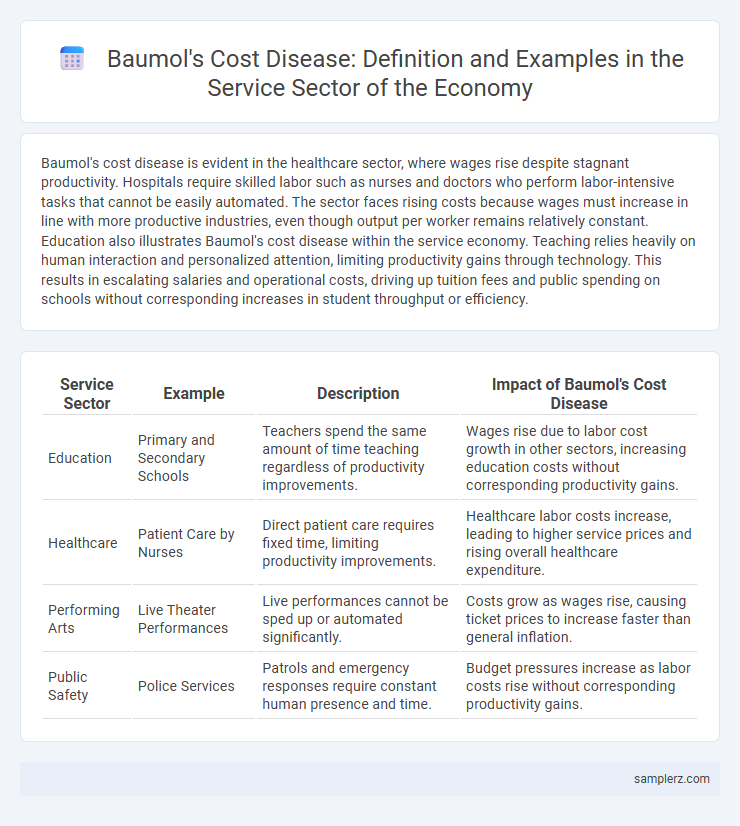Baumol's cost disease is evident in the healthcare sector, where wages rise despite stagnant productivity. Hospitals require skilled labor such as nurses and doctors who perform labor-intensive tasks that cannot be easily automated. The sector faces rising costs because wages must increase in line with more productive industries, even though output per worker remains relatively constant. Education also illustrates Baumol's cost disease within the service economy. Teaching relies heavily on human interaction and personalized attention, limiting productivity gains through technology. This results in escalating salaries and operational costs, driving up tuition fees and public spending on schools without corresponding increases in student throughput or efficiency.
Table of Comparison
| Service Sector | Example | Description | Impact of Baumol's Cost Disease |
|---|---|---|---|
| Education | Primary and Secondary Schools | Teachers spend the same amount of time teaching regardless of productivity improvements. | Wages rise due to labor cost growth in other sectors, increasing education costs without corresponding productivity gains. |
| Healthcare | Patient Care by Nurses | Direct patient care requires fixed time, limiting productivity improvements. | Healthcare labor costs increase, leading to higher service prices and rising overall healthcare expenditure. |
| Performing Arts | Live Theater Performances | Live performances cannot be sped up or automated significantly. | Costs grow as wages rise, causing ticket prices to increase faster than general inflation. |
| Public Safety | Police Services | Patrols and emergency responses require constant human presence and time. | Budget pressures increase as labor costs rise without corresponding productivity gains. |
Understanding Baumol’s Cost Disease in the Service Sector
Baumol's cost disease occurs in the service sector when wages rise despite stagnant productivity, as seen in industries like healthcare and education where labor-intensive tasks cannot be easily automated. For example, a teacher's salary increases to compete with wages in more productive sectors, yet the number of students taught per hour remains constant. This wage inflation without corresponding productivity growth leads to higher overall costs in essential services.
Key Drivers Behind Rising Service Costs
Baumol's cost disease highlights how labor-intensive service sectors like education and healthcare experience rising costs due to stagnant productivity growth compared to manufacturing. Key drivers behind escalating service costs include the necessity for skilled labor, limited scope for automation, and wage increases driven by productivity gains in other industries. This dynamic results in persistent cost inflation despite minimal improvements in output efficiency.
Education: A Classic Case of Baumol’s Cost Disease
Education exemplifies Baumol's cost disease as labor-intensive teaching requires consistent human effort, limiting productivity gains compared to manufacturing. Rising education costs result from wage increases necessary to retain skilled educators despite stagnant technological productivity in classroom instruction. This dynamic drives tuition inflation and budgetary pressures within universities and schools worldwide.
Healthcare Sector and Baumol’s Cost Inflation
Baumol's cost disease in the healthcare sector is evident as labor-intensive services like nursing and medical care experience rising wages without corresponding productivity gains, driving up overall healthcare costs. This phenomenon, known as Baumol's cost inflation, results from stable output quantities but increasing input expenses due to wage competition with more productive sectors. Consequently, healthcare providers face escalating operational costs, contributing to persistent inflation in healthcare prices.
Performing Arts: Price Growth Explained by Baumol’s Theory
In the performing arts sector, Baumol's cost disease manifests through rising ticket prices despite stagnant productivity gains, as live performances require a fixed labor input and cannot be easily mechanized. This phenomenon causes labor costs to increase faster than output, driving up operational expenses and ticket prices over time. Consequently, theaters and orchestras face financial pressures to balance quality performances with escalating wage demands in a low-productivity growth environment.
Legal Services: Stagnant Productivity and Escalating Costs
Legal services exemplify Baumol's cost disease as productivity in tasks like court appearances and client consultations remains stagnant due to their labor-intensive nature. Despite limited efficiency gains, wages rise to compete with other sectors, driving up the overall cost of legal services. This imbalance causes escalating expenses without corresponding increases in service output or quality.
Childcare Services: Impact of Baumol’s Cost Disease
Childcare services illustrate Baumol's cost disease as labor-intensive tasks in this sector require constant staffing despite limited productivity gains, driving up costs faster than inflation. Wage increases in childcare mirror those in more productive industries, resulting in disproportionate price growth for services that cannot easily automate or streamline. This dynamic creates affordability challenges for families and pressures on public funding to maintain service quality.
Public Administration and Wage Pressures
Baumol's cost disease in the public administration sector manifests through stagnant productivity growth coupled with rising wage pressures driven by the need to retain skilled employees. Despite limited efficiency gains, wage increases mirror those in more productive industries, causing escalating operational costs without corresponding service output improvements. This dynamic intensifies budget constraints for government agencies, highlighting persistent challenges in balancing compensation demands with fiscal responsibility.
Hospitality Industry: Rising Wages Without Productivity Gains
In the hospitality industry, Baumol's cost disease is evident as wages increase despite stagnant productivity levels, driven by the labor-intensive nature of services like housekeeping and food preparation. Hotels and restaurants face rising operating costs because these essential tasks cannot be easily automated or sped up without compromising quality. This dynamic results in higher prices for consumers without corresponding improvements in service efficiency.
Managing the Effects of Baumol’s Cost Disease in Services
Managing the effects of Baumol's cost disease in the service sector involves enhancing productivity through technology integration and process innovation, particularly in healthcare and education where labor intensity remains high. Investment in digital tools, telemedicine, and online learning platforms can mitigate rising costs by streamlining operations and improving service delivery efficiency. Policymakers and managers should prioritize resource allocation toward scalable technology to balance rising wages with sustainable service quality.

example of Baumol's cost disease in service sector Infographic
 samplerz.com
samplerz.com